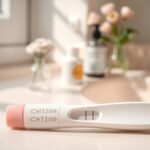Welcoming a newborn is a joyous yet transformative experience for new mothers. Following a vaginal delivery, the postpartum recovery process can involve a range of physical and emotional changes. This comprehensive guide aims to equip you with the essential information needed to navigate this pivotal phase of early motherhood effectively.
From understanding the initial 24 hours after childbirth to managing the ongoing physical and mental health challenges, this article provides a roadmap for a smooth postpartum recovery. Whether you’re preparing for your first child or expanding your family, this resource will empower you to create a personalized postpartum plan that prioritizes your well-being and supports a positive transition into the next chapter of your life.
Key Takeaways
- Gain insight into the physical changes and immediate recovery process after a vaginal delivery.
- Discover essential self-care practices, including personal hygiene, rest, and nutrition, to support your postpartum healing.
- Learn strategies to manage the emotional and mental health challenges that may arise during the recovery period.
- Understand the importance of a supportive network and partner involvement in your postpartum journey.
- Explore safe and gradual physical activity guidelines to help you regain strength and mobility.
Understanding the Initial 24 Hours After Vaginal Delivery
The first 24 hours following a vaginal birth are a critical period for both the mother and the newborn. During this time, you can expect significant physical changes, close medical monitoring, and the need to manage postpartum discomfort.
Physical Changes and Immediate Recovery
After delivery, you may experience postpartum bleeding as your uterus contracts to expel the placenta and begin the healing process. This postpartum bleeding is normal and can last for several weeks. Additionally, you may feel uterine contractions as your uterus shrinks back to its pre-pregnancy size.
If you had any perineal care, such as stitches, the area may be sore and swollen. Proper wound care and pain management will be essential during this time.
Hospital Care and Medical Monitoring
The hospital staff will closely monitor you and your baby’s vital signs, ensuring a safe and healthy recovery. They will check your postpartum bleeding, monitor your uterine contractions, and assess your overall physical and emotional well-being.
Regular checks of your temperature, blood pressure, and heart rate will help the medical team identify any potential complications and address them promptly.
Managing Pain and Discomfort
The hospital staff will work with you to develop a pain management plan to address any discomfort you may be experiencing. This may include medication, ice packs, or other techniques to help alleviate postpartum bleeding, uterine contractions, and any perineal care needs.
It’s important to communicate openly with your healthcare providers about your pain levels and any concerns you may have during this critical recovery period.
The First Week of Postpartum Recovery
The first week after a vaginal delivery can be both exhilarating and challenging for new mothers. As your body adjusts to the changes of childbirth, you may experience a range of physical and emotional experiences, from afterpains and lochia to breast engorgement and postpartum fatigue. Understanding what to expect during this crucial time can help you better navigate the initial recovery process.
One of the most common experiences in the first week is afterpains – the contractions that occur as your uterus shrinks back to its pre-pregnancy size. These can be quite uncomfortable, but over-the-counter pain medication and warm compresses can provide relief. Similarly, lochia, or the postpartum bleeding, is normal and will gradually decrease in volume and redness over the first week.
As your milk comes in, you may also experience breast engorgement, which can cause your breasts to feel heavy, tender, and swollen. Frequent breastfeeding or expressing milk can help alleviate this discomfort, and your healthcare provider may recommend additional strategies to manage this common postpartum challenge.
Finally, it’s important to be aware of and manage postpartum fatigue. The physical and emotional demands of caring for a newborn can be overwhelming, so prioritizing rest, proper nutrition, and support from your loved ones will be crucial during this time.
By understanding the common experiences of the first postpartum week, you can better prepare and care for yourself as you embark on this new chapter of motherhood.
Essential Self-Care Practices for New Mothers
As a new mother, it’s crucial to prioritize your own well-being during the postpartum recovery period. Focusing on essential self-care practices can not only help you heal but also provide the energy and resilience you need to care for your newborn. Let’s explore the key aspects of self-care that every new mom should consider.
Personal Hygiene and Wound Care
Maintaining good personal hygiene is vital for perineal healing and preventing infections. Gently clean the perineal area with warm water and mild soap, and consider using sitz baths to soothe discomfort. Keep the area clean and dry, and don’t hesitate to reach out to your healthcare provider if you have any concerns about your healing process.
Rest and Sleep Management
Postpartum sleep deprivation is a common challenge, but it’s essential to prioritize rest whenever possible. Establish a sleep routine, try to nap when your baby naps, and enlist help from family and friends to allow you to get the sleep you need. Remember, your recovery is just as important as your baby’s care.
Nutrition and Hydration Tips
Proper postpartum nutrition is crucial for your recovery and breastfeeding, if applicable. Aim to eat a balanced diet rich in lean proteins, fruits, vegetables, and whole grains. Stay hydrated by drinking plenty of water, and consider incorporating nutrient-dense snacks throughout the day to keep your energy levels up.
By embracing these essential self-care practices, you can support your physical and emotional well-being during this transformative time. Remember, taking care of yourself is not selfish; it’s necessary for you to be the best version of yourself for your new family.
Managing Physical Changes and Healing
Postpartum recovery is a journey filled with both physical and emotional changes. As your body adjusts after giving birth, it’s essential to understand and address the various physical transformations you may experience. From pelvic floor exercises to managing postpartum hair loss and skin changes, this section provides guidance on navigating the healing process.
Pelvic Floor Rehabilitation
The pelvic floor muscles play a crucial role in supporting your organs and regaining control after childbirth. Engaging in regular pelvic floor exercises, such as Kegels, can help strengthen these muscles and improve bladder control, bowel function, and sexual health. Work closely with your healthcare provider or a pelvic floor physical therapist to develop a personalized rehabilitation plan.
Postpartum Hair Loss
It’s common to experience postpartum hair loss in the months following delivery. This shedding is often a result of hormonal changes and is a temporary condition. To manage hair loss, consider using gentle hair care products, avoiding excessive heat styling, and incorporating hair-healthy nutrients into your diet.
Skin Changes and C-Section Scar Care
Pregnancy and childbirth can bring about various skin changes, including stretch marks, pigmentation changes, and dryness. If you’ve had a cesarean delivery, proper c-section scar care is essential for promoting healing and minimizing the appearance of the scar. Consult with your healthcare provider about appropriate skincare products and techniques to address your specific concerns.
| Physical Change | Recommended Strategies |
|---|---|
| Pelvic Floor Weakness | Kegel exercises, pelvic floor physical therapy |
| Postpartum Hair Loss | Gentle hair care, hair-healthy diet, patience |
| Skin Changes | Moisturize, use sun protection, consult a dermatologist |
| C-Section Scar | Follow wound care instructions, use scar treatments |
Remember, every postpartum journey is unique, and it’s essential to listen to your body and work closely with your healthcare team to address any physical changes or concerns. With patience and the right self-care strategies, you can navigate the healing process and emerge stronger than ever.
Creating Your Postpartum Plan for Optimal Recovery
As a new mother, developing a comprehensive postpartum plan can be instrumental in ensuring a smooth and successful recovery. This plan should address key aspects of your support system, daily routine, and recovery timeline expectations.
Support System Organization
Surrounding yourself with a strong network of family, friends, and professionals can make all the difference during the postpartum period. Take time to identify and organize your postpartum support resources, including:
- Trusted friends or family members who can assist with childcare assistance
- Meal delivery services or helpful loved ones for meal planning
- Healthcare providers, lactation consultants, and support groups for medical guidance and emotional support
Daily Routine Establishment
Establishing a manageable daily routine can help you navigate the postpartum period with greater ease. Consider incorporating:
- Scheduled rest periods and recovery milestones
- Dedicated time for self-care, including personal hygiene and gentle exercise
- Streamlined tasks like meal planning and household chores
Recovery Timeline Expectations
Understand that every woman’s postpartum recovery journey is unique. However, setting realistic expectations can help you better prepare for the physical and emotional changes ahead. Be mindful of common recovery milestones and seek guidance from your healthcare provider to ensure a safe and healthy recovery.
“Creating a postpartum plan that addresses your specific needs and resources can empower you to navigate the recovery process with greater confidence and resilience.”
Emotional and Mental Health During Recovery
Navigating the postpartum period can be an emotional roller coaster for new mothers. While the joy of welcoming a new life is unparalleled, the physical and hormonal changes can also lead to feelings of postpartum depression, anxiety, and the “baby blues.” It’s essential to understand these common maternal mental health challenges and seek the necessary support during this transformative time.
The “baby blues” are a temporary and mild form of emotional distress that can arise in the first few weeks after childbirth. Symptoms may include mood swings, irritability, crying spells, and difficulty sleeping. These feelings are a natural response to the significant hormonal shifts and the demands of caring for a newborn. With time and self-care, the baby blues typically subside within a couple of weeks.
However, for some women, the emotional turmoil can persist or worsen, leading to postpartum depression. This more severe and persistent form of depression can interfere with a new mother’s ability to function and bond with her baby. Symptoms may include persistent sadness, loss of interest, feelings of worthlessness, and thoughts of harming oneself or the baby. It’s crucial to recognize the signs and seek professional help if these feelings last longer than two weeks.
Anxiety is another common experience during the postpartum period. New mothers may feel overwhelmed by the responsibilities of caring for a newborn, leading to excessive worry, panic attacks, or even avoidance of certain situations. Addressing these maternal mental health concerns through therapy, support groups, and medication (if necessary) can help mothers navigate this challenging transition with greater ease.
Remember, you are not alone in your emotional journey. Reaching out to healthcare providers, loved ones, and support networks can make all the difference in managing the ups and downs of postpartum recovery. With the right care and resources, you can prioritize your mental health and enjoy this special time in your life.
Physical Activity and Exercise Guidelines
Postpartum recovery is not just about physical healing; it’s also about gradually reintroducing physical activity and exercise. As you navigate this journey, it’s crucial to follow safe movement techniques, establish a gradual exercise progression, and be mindful of any warning signs that may indicate the need to slow down or seek medical advice.
Safe Movement Techniques
In the early postpartum period, it’s important to focus on gentle, low-impact exercises that promote healing and strength without straining your body. Kegel exercises, which target the pelvic floor muscles, are an excellent place to start. These exercises can help address any issues related to diastasis recti (abdominal separation) and support your overall core stability.
Gradual Exercise Progression
- Begin with simple, daily walks, gradually increasing the duration and intensity as you feel comfortable.
- Incorporate light strength training exercises, focusing on your upper body and lower body, to rebuild muscle tone.
- Introduce postpartum exercise routines that incorporate core-strengthening movements, but always listen to your body and adjust as needed.
Warning Signs to Watch For
As you increase your physical activity, be mindful of any warning signs that may indicate you need to slow down or seek medical attention. These may include:
- Persistent pain or discomfort
- Excessive bleeding or vaginal discharge
- Dizziness or lightheadedness
- Decreased milk supply
Remember, every postpartum recovery journey is unique, so it’s essential to work closely with your healthcare provider to develop a personalized plan that supports your physical and mental well-being.
When to Contact Your Healthcare Provider
The postpartum recovery period is a delicate time, and it’s crucial to be vigilant for any signs of potential complications. While some discomfort is normal, there are certain symptoms that warrant a prompt visit to your healthcare provider. By understanding when to seek medical attention, you can ensure a safe and smooth recovery.
One of the most concerning postpartum complications is excessive bleeding or hemorrhage. If you experience bleeding that soaks more than one sanitary pad per hour, or if the bleeding is accompanied by dizziness, rapid heartbeat, or lightheadedness, contact your provider immediately. Excessive bleeding can be a sign of a serious underlying issue and requires prompt medical intervention.
Another potential complication is postpartum fever. If your temperature exceeds 100.4°F (38°C), it’s essential to reach out to your healthcare provider. Fever can be a sign of infection, such as mastitis, a painful breast inflammation caused by a bacterial infection. Prompt treatment is crucial to prevent the spread of infection and ensure a speedy recovery.
- Excessive bleeding or hemorrhage
- Fever exceeding 100.4°F (38°C)
- Signs of mastitis, such as redness, swelling, and pain in the breast
- Severe or persistent pain, including in the perineum or incision site
- Inability to urinate or have a bowel movement
- Persistent nausea, vomiting, or diarrhea
- Symptoms of postpartum depression, such as persistent sadness, anxiety, or thoughts of harming yourself or your baby
If you experience any of these symptoms or have any other concerns about your postpartum recovery, don’t hesitate to contact your healthcare provider. They are there to support you and ensure your well-being during this important transition.
Partner Support and Family Involvement
As a new mother, navigating postpartum recovery can be a delicate and overwhelming experience. However, the support and involvement of your partner and family can make a significant difference in your journey. This section explores the crucial role of communication strategies, practical help distribution, and bonding opportunities to foster a nurturing environment for you, your partner, and your growing family.
Communication Strategies
Open and honest communication with your partner is the foundation for a successful co-parenting relationship during this transitional period. Establish regular check-ins to discuss your needs, concerns, and expectations. Encourage your partner to actively listen and offer emotional support, ensuring you feel heard and understood.
Practical Help Distribution
- Delegate household tasks and responsibilities with your partner to alleviate the burden on you.
- Enlist the help of trusted family members or friends to assist with meal preparation, childcare, or other practical matters.
- Accept offers of help graciously and communicate your specific needs to ensure the support provided is truly beneficial.
Bonding Opportunities
Fostering family bonding during the postpartum period is crucial for the adjustment of new parents and the development of a strong family unit. Engage in activities that promote connection, such as:
- Shared feedings or diaper changes with your partner
- Family outings or walks to explore the neighborhood with your baby
- Quiet moments of affection and skin-to-skin contact with your little one
By prioritizing communication, practical help, and bonding opportunities, you can create a supportive environment that allows you to focus on your postpartum recovery and the joyful transition into parenthood. With the involvement of your partner and family, you can navigate the challenges of new parenthood with greater ease and find moments of cherished connection along the way.
Common Challenges and Solutions
Postpartum recovery can bring a range of challenges, but with the right strategies, new mothers can navigate these obstacles with confidence. One common issue is breastfeeding difficulties, which can be addressed through lactation support, adjusting latch techniques, and addressing any underlying medical concerns.
Postpartum constipation is another frequent concern, which can be alleviated through a diet rich in fiber, staying hydrated, and incorporating gentle exercise. Changes in sexual health and body image are also common during this period, and open communication with partners, seeking professional guidance, and practicing self-compassion can help mothers adjust to these transformations.
By acknowledging these challenges and implementing practical solutions, new mothers can prioritize their well-being and enjoy the rewarding journey of postpartum recovery.
FAQ
What are the initial physical changes and recovery steps after a vaginal delivery?
In the first 24 hours after a vaginal birth, you can expect physical changes like postpartum bleeding, uterine contractions, and perineal discomfort. The hospital staff will monitor your condition and provide pain management support during this time.
How can I manage the challenges of the first week of postpartum recovery?
During the first week, you may experience afterpains, lochia (postpartum bleeding), breast engorgement, and postpartum fatigue. Practicing self-care techniques like pelvic rest, hydration, and sleep management can help you adapt to life with a newborn.
What essential self-care practices should I focus on for optimal postpartum recovery?
Prioritize personal hygiene, wound care, rest, and proper nutrition and hydration. Strategies like sitz baths, pelvic floor exercises, and nutritious meal planning can support your physical healing and well-being.
How can I create an effective postpartum plan to guide my recovery?
Organizing a support system, establishing a daily routine, and setting realistic recovery expectations are key aspects of a comprehensive postpartum plan. This will help you navigate the challenges of early motherhood with more ease.
What are the signs that I should contact my healthcare provider during postpartum recovery?
Contact your provider if you experience concerning symptoms like fever, excessive bleeding, or signs of infection or mastitis. It’s important to differentiate normal recovery experiences from potential complications that require medical attention.
How can my partner and family provide meaningful support during my postpartum recovery?
Open communication, practical help with household tasks, and shared bonding opportunities can make a significant difference. Involving your partner and family in your postpartum journey can create a more supportive environment for you and your new baby.
What are some common postpartum challenges and effective solutions?
Challenges like breastfeeding difficulties, postpartum constipation, changes in sexual health, and body image concerns are all common experiences. Seeking guidance from healthcare providers and implementing coping strategies can help you overcome these obstacles.







